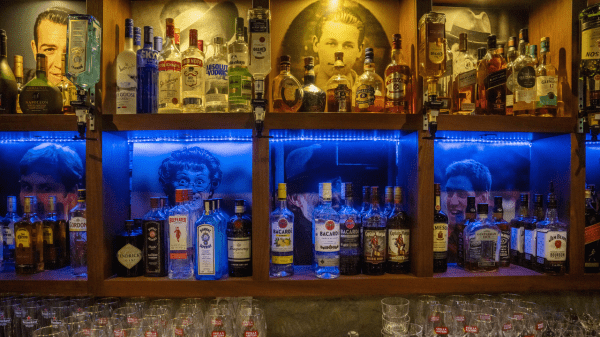
I drank a lot when I lived in Qatar.
I drank with Americans, Arabs, Aussies, and Indians, Irish and French people, British bros and British toffs. With marines, Al Jazeera journalists, professors, gas-extraction engineers, State Department stiffs, and the rare female friends, whom I cherished, in a country filled with way too many men. We drank at house parties, on dhows far from shore, in the middle of the desert, in swanky hotel bars, at the golf club, and on little porches overlooking a city still being built. I sat paralyzed in more than a couple of passenger-side seats, worried my driver would be Breathalyzed and deported (a zero-tolerance policy reigned supreme), and spent many weekend afternoons browsing the liquor store out on the edge of town, not too far from Our Lady of the Rosary, the Catholic church that had gone up in 2008. The rumor was that the church and the liquor store were on their own entirely separate electrical grid to satisfy the conservative Qataris, who disapproved of the existence of both.
The church, the liquor store, and the drinking were the provenance of expats, and there were a lot of us—a couple million, compared with only a couple hundred thousand Qatari nationals. The population imbalance was tipped by the discovery, in 1971, of massive reserves of natural gas in the waters separating Qatar from Iran. Before then, Qatar had been a British protectorate mostly known for pearl diving, fishing, and a Bedouin way of life. But, after the gas discovery, change came quickly; in order to extract its wealth from the earth, Qatar needed to bring in people who had the know-how to build enormous plants, and the laborers—preferably as cheap as possible—to do the grunt work.
I came to Qatar to work at Georgetown University’s campus in Doha, the capital city, in 2009, which was twelve years after the country’s first liquefied-natural-gas plant came online, in 1997. I was there the day the news was announced that Qatar had won its World Cup bid. Caught up in the excitement, I drove down to the corniche, the curving road that runs along Doha Bay, and watched as thousands—including many Indians, Pakistanis, Palestinians, and Egyptians, whose families have lived in Qatar for decades—honked their horns and waved the maroon-and-white Qatari standard. The joy seemed in large part due to the recognition that the World Cup bestowed on a country not many people had heard of. (The U.S. Justice Department has presented evidence suggesting that bribery was what helped bring the cup to Qatar, but there have been no convictions. Qatari officials have denied the allegations, and an earlier inquiry by FIFA’s ethics committee found no evidence of bribery.)
But there were always questions about what the World Cup would actually look like in Qatar. The place is tiny and hot, for one thing (not a dry heat, either, contrary to popular belief)—a little thumb jutting off the Arabian Peninsula. And, like its neighbor Saudi Arabia, Qatar adheres to the conservative Wahhabi branch of Islam; drunken fans aren’t common at the country’s sporting events. When I saw the news that, at the last minute, authorities had banned beer at stadiums, I wasn’t all that surprised. It was the kind of sharp assertion of Qatari identity that tracks with the country’s tortured relationship with the outside forces that have helped mold it into a money-soaked modern emirate.
Once the gas was discovered, change accelerated under the reign of the relatively liberal Emir Hamad Bin Khalifa Al Thani, who had overthrown his father in a bloodless coup, in 1995. Qatari grandparents who had tended herds in the desert found themselves living out their dotage in the hyper-air-conditioned marble palaces of their children and grandchildren. When the Doha Sheraton, a beige, “Star Wars”-looking triangle of a building, opened in 1982, it was pretty much the only tall structure in the country. Now Doha’s skyline is packed with gleaming towers—glass-and-metal icicles in the desert.
As Western expats funnelled in—to help run the gas plants, design the new buildings, teach in the universities, and build out the medical system—they brought along certain demands. Their lives in this barren desert country were to be made comfortable. The primarily South Asian and Filipino migrants who work construction in brutal heat, and who staff homes and offices—living under kafala, a “sponsorship” system that grew out of British labor practices in the region and which involves the confiscation of a worker’s passport—couldn’t assert the same demands. The white-collar Arab and South Asian expats who had lived in Qatar long before the influx of Westerners seemed less inclined to agitate. And, yes, the social structure was and is all redolent of colonialism, except the Qataris are ultimately in charge. For Westerners, the pay was high if you were willing to take the leap. Can’t make it in London? Try Qatar! The houses were gated, with pools, and live-in help was cheap (see: kafala), but the boredom quotient was off the charts.
Drinking became a fixation for many—because it was fun and social, sure, but there was also a nose-thumbing aspect to it. You lived your whole workweek wearing conservative clothes in a-hundred-and-twenty-plus-degree heat, going to censored movies at the theatre, and growing tired of the endless mall walks. A Hendrick’s and cucumber was a taste of home and a private statement of defiance; drinking in Doha must be done in sanctioned hotels and clubs, or at your residence, after you’ve obtained a liquor license through your employer, stating that you are not a Muslim.
Alcohol, so central to so many cultures and such anathema to the Qatari one, is a natural trigger point in what is a somewhat reluctantly multicultural society. It’s why the World Cup controversy could have been foreseen. Beer at stadiums would have crossed an important line of private versus public consumption of alcohol, and, in Qatar, the boundaries between those realms is sacrosanct. Rules like no eating or drinking in public during Ramadan are other pointed assertions of values that grate on some expats; house parties ramp up during the holiest month of the Islamic calendar. “Ramadan is dry but not at the Marine House!” an old invite that I recently pulled up blared. It’s an impulse that is, admittedly, more than a little puerile.
The small population of Qataris holds itself apart from the rest of the country. An invitation to a Qatari home for a Westerner is a rarity. I never saw the inside of one, but I went to the women’s portion of a large wedding once, and was tickled that, when the abayas came off, I was one of the more conservatively dressed attendees. The cleavage and side boob on display were worthy of a Kardashian photo-call. My phone was confiscated at the door (not that I would have dared pull it out). I thought of that when I watched a Danish news crew arguing with Qatari authorities last week. “You invited the whole world to come here—why can’t we film? It’s a public place,” the reporter said. A fair point. But, in Qatar, behavior in public spaces is highly regulated; when I lived there, men and women couldn’t hold hands in public, and taking a photo that might capture a Qatari woman was considered the height of rudeness, if not grounds for the seizure of your camera.
Even as Qatar has sought the trappings of Western status—the purchases of London’s Shard tower, the Harrods department store, and, of course, the World Cup—it has pursued a selective sort of public cultural preservation. The old Msheireb neighborhood, once filled with Arab and South Asian businesses, was partially razed and rebuilt as a modern district, with buildings meant to reinterpret Qatari architecture. The project’s luxury accommodations are meant to attract Qataris—many of whom have moved to mansions farther afield—back to the city center. In a country filled with migrants, this would be an internal migration freighted with meaning, a pointed reclamation.
The Qataris’ fear of being culturally subsumed is, of course, wholly understandable. A people who are so outnumbered in their own country as the Qataris inevitably face an onslaught of seismic cultural shifts. Some Qataris drink. There was one slightly tumbledown hotel in the old city center where you’d see thobes amid the beers, a bit of a taboo. More darkly, when I first moved to Doha, there were murmurs that a young Qatari woman had been killed by her family when she’d been discovered at a bar. Though, in a country with no free press—V.P.N.s are common to get around Internet censors—there’s no way to prove whether it really happened.
The World Cup is the most high-profile test of Qatari adamance. The last-minute beer ban might have been embarrassing to FIFA, contractually dubious, and inflammatory to the thousands of soccer hooligans descending on the country. But you have to give it to the Qataris on one point: they know when they have the upper hand. The show will go on. Soberly. ♦
Sourse: newyorker.com






